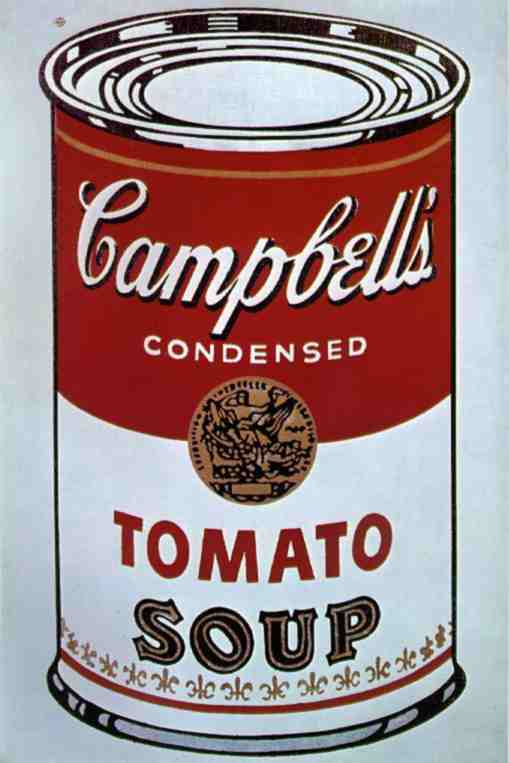The literal definition through Merriam-Webster is as follows:
Main Entry: pop art
Function: noun
Usage: often capitalized
Date: 1957
: art in which commonplace objects (as road signs, hamburgers, comic strips, or soup cans) are used as subject matter and are often physically incorporated in the work
— pop artist noun often capitalized P
Of course, everyone thinks of Andy Warhol first. There could probably be no more recognizable symbol of the Pop Art movement than the Campbell's Soup Can. However, there is a long list of artists that are included in this movement, like Roy Lichtenstein, David Hockney, and Jasper Johns that aren't as recognizable. (If you have purchased lot art in the last decade and haven't heard of these artists, look them up.)
Art, like anything else, has a cutting edge of ideas that eventually filters down to others who want to try similar ideas. From parodies of different kinds of art techniques, to company logos would have been a logical transition.
The earliest example I was able to find of this was a poster for a fraternity at an antiques store a few months ago. It was a Budweiser Parody for a school dance, or function. Unfortunately I have deleted the picture, but the date on the poster was from the early 60's. From that point, it's easy to see the jump to T Shirts and Stickers for touring bands like the Grateful Dead, and eventually the Phish parking lot.
 The legality of the more recent items has been the source of much debate, both constructive and ridiculous. You may remember Knighthood finally won after a court ruling determined:
The legality of the more recent items has been the source of much debate, both constructive and ridiculous. You may remember Knighthood finally won after a court ruling determined:
"...it is just as likely that many Phish fans are sophisticated enough to understand the difference between plaintiffs' items, which clearly display an official, registered 'Phish' logo," stated Murtha, "and the defendants items, which uniformly and prominently incorporate artwork associated with other, non-Phish products."
I don't claim to be an expert Art Historian, or even serious art collector, but the history of the items we all love so much is a very interesting one indeed.
Art, like anything else, has a cutting edge of ideas that eventually filters down to others who want to try similar ideas. From parodies of different kinds of art techniques, to company logos would have been a logical transition.
The earliest example I was able to find of this was a poster for a fraternity at an antiques store a few months ago. It was a Budweiser Parody for a school dance, or function. Unfortunately I have deleted the picture, but the date on the poster was from the early 60's. From that point, it's easy to see the jump to T Shirts and Stickers for touring bands like the Grateful Dead, and eventually the Phish parking lot.
 The legality of the more recent items has been the source of much debate, both constructive and ridiculous. You may remember Knighthood finally won after a court ruling determined:
The legality of the more recent items has been the source of much debate, both constructive and ridiculous. You may remember Knighthood finally won after a court ruling determined:"...it is just as likely that many Phish fans are sophisticated enough to understand the difference between plaintiffs' items, which clearly display an official, registered 'Phish' logo," stated Murtha, "and the defendants items, which uniformly and prominently incorporate artwork associated with other, non-Phish products."
I don't claim to be an expert Art Historian, or even serious art collector, but the history of the items we all love so much is a very interesting one indeed.



Glide/Tide is one of my favorite shirts ever. Still regret not buying one when I had the chance.
ReplyDelete